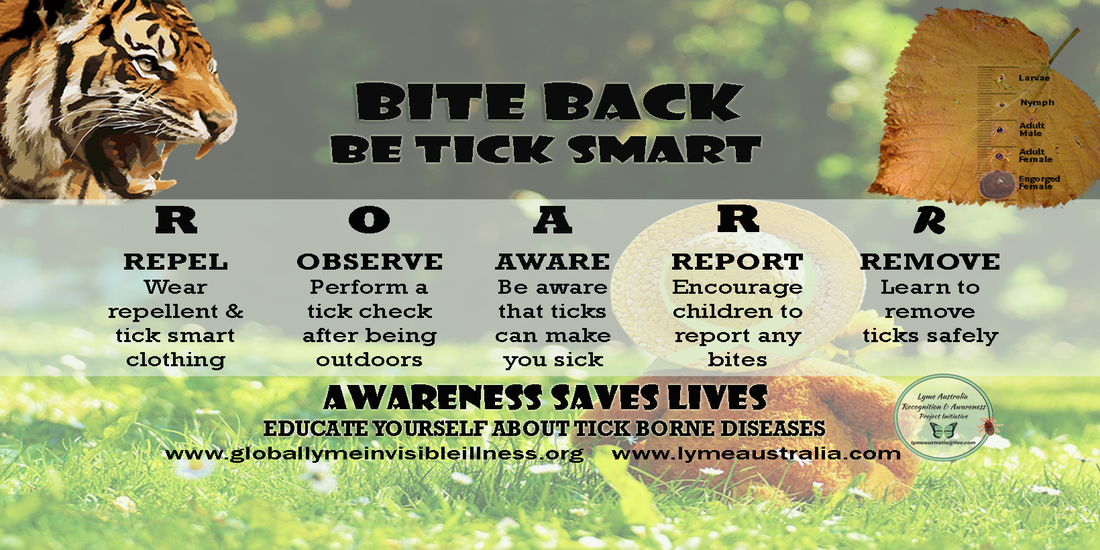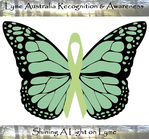ROARR TICK AWARENESS CAMPAIGN
Being Tick Aware is paramount in preventing Tick Borne Diseases. While working on the Stand with Us: School Campaign this year, Karen (Lyme Australia Recognition & Awareness) developed and designed the complementary ROARR campaign.
In addition to the school campaign - that encourages our children to be supportive of others in their community by wearing green - the ROARR campaign was designed as a memorable way to educate children (and adults) and to encourage them to be proactive with regards to tick awareness by using the 'catchy' acronym R.O.A.R.R: Repel, Observe, Aware, Report, Remove.
For Information on Ticks and Human Disease Please see Transmission & Maintenance Page of this website, which explains how ticks can transmit infections to humans. The majority of information covers Borrelia / Lyme infections. Co-infections, such as Babesia are also discussed on the website and currently being linked.
In addition to the school campaign - that encourages our children to be supportive of others in their community by wearing green - the ROARR campaign was designed as a memorable way to educate children (and adults) and to encourage them to be proactive with regards to tick awareness by using the 'catchy' acronym R.O.A.R.R: Repel, Observe, Aware, Report, Remove.
For Information on Ticks and Human Disease Please see Transmission & Maintenance Page of this website, which explains how ticks can transmit infections to humans. The majority of information covers Borrelia / Lyme infections. Co-infections, such as Babesia are also discussed on the website and currently being linked.
|
Please feel free to download and use the ROARR Campaign Cover opposite.
It can also be shared directly from Lyme Australia Recognition & Awareness Facebook Page. See Below for an expanded version of the ROARR acronym. |
ROARR Expanded
Repel: Wear repellent and tick smart clothing: Wear repellent when heading outside to play / walk. When participating in activities such as bushwalking, tuck pants into long white socks. Tucking pants in will deter ticks from crawling up the inside of pants legs and light colours will make it easier to see ticks.
Observe: Perform a tick check after being outdoors. Make it a part of your routine to do a tick check after playing / walking outside. Remember to check in warm places such as behind the ears, in the hair and under the arms, where ticks like to hide.
Aware: Be aware that ticks can make you sick. By raising awareness that ticks can carry pathogens (bacteria, parasites, viruses) that can cause diseases in humans (as well as animals), people will know the importance of preventative measures and seeking medical attention if they start to feel sick, or develop a rash after a bite.
Report: Encourage children to report suspected bites. Educate children to inform parents / teachers if feeling a sting, or suspect they might have been bitten by a tick / insect after playing outside.
Remove: Learn to remove ticks safely. Safe removal of a tick may decrease the risk of any pathogens being transferred. Some tips in brief: DO: Use fine-tipped tweezers and grasp the tick as close to the skin as possible, pulling slowly upwards. Once the tick is removed, clean the area with a disinfectant. DO NOT: Put anything on the tick when it is attached (the tick may regurgitate stomach contents/ potential pathogens) or squash the tick in your fingers. Save the tick in a plastic bag to be sent for laboratory testing.
Observe: Perform a tick check after being outdoors. Make it a part of your routine to do a tick check after playing / walking outside. Remember to check in warm places such as behind the ears, in the hair and under the arms, where ticks like to hide.
Aware: Be aware that ticks can make you sick. By raising awareness that ticks can carry pathogens (bacteria, parasites, viruses) that can cause diseases in humans (as well as animals), people will know the importance of preventative measures and seeking medical attention if they start to feel sick, or develop a rash after a bite.
Report: Encourage children to report suspected bites. Educate children to inform parents / teachers if feeling a sting, or suspect they might have been bitten by a tick / insect after playing outside.
Remove: Learn to remove ticks safely. Safe removal of a tick may decrease the risk of any pathogens being transferred. Some tips in brief: DO: Use fine-tipped tweezers and grasp the tick as close to the skin as possible, pulling slowly upwards. Once the tick is removed, clean the area with a disinfectant. DO NOT: Put anything on the tick when it is attached (the tick may regurgitate stomach contents/ potential pathogens) or squash the tick in your fingers. Save the tick in a plastic bag to be sent for laboratory testing.


